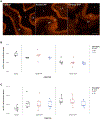Changes in nerve growth factor signaling in female mice with cyclophosphamide-induced cystitis
- PMID: 37701183
- PMCID: PMC10493645
- DOI: 10.3389/fruro.2022.1089220
Changes in nerve growth factor signaling in female mice with cyclophosphamide-induced cystitis
Abstract
IC/BPS is a chronic inflammatory pelvic pain syndrome characterized by lower urinary tract symptoms including unpleasant sensation (pain, pressure, or discomfort) in the suprapubic or bladder area, as well as increased urinary frequency and urgency, and decreased bladder capacity. While its etiology remains unknown, increasing evidence suggests a role for changes in nerve growth factor (NGF) signaling. However, NGF signaling is complex and highly context dependent. NGF activates two receptors, TrkA and p75NTR, which activate distinct but overlapping signaling cascades. Dependent on their coexpression, p75NTR facilitates TrkA actions. Here, we show effects of CYP treatment and pharmacological inhibition of p75NTR (via LM11A-31) and TrkA (ARRY-954) on NGF signaling-related proteins: NGF, TrkA, phosphorylated (p)-TrkA, p75NTR, p-ERK1/2, and p-JNK. Cystitis conditions were associated with increased urothelial NGF expression and decreased TrkA and p75NTR expression as well as altering their co-expression ratio; phosphorylation of ERK1/2 and JNK were also altered. Both TrkA and p75NTR inhibition affected the activation of signaling pathways downstream of TrkA, supporting the hypothesis that NGF actions during cystitis are primarily TrkA-mediated. Our findings, in tandem with our recent companion paper demonstrating the effects of TrkA, TrkB, and p75NTR inhibition on bladder function in a mouse model of cystitis, highlight a variety of potent therapeutic targets and provide further insight into the involvement of NGF signaling in sustained conditions of bladder inflammation.
Keywords: c-Jun N-terminal kinase (JNK); extracellular signal-regulated kinase (ERK1/2); interstitial cystitis/bladder pain syndrome (IC/BPS); lower urinary tract (LUT); nerve growth factor; neurotrophin (NT); p75 NTR; tropomyosin receptor kinase (TrkA).
Conflict of interest statement
Conflict of interest The authors declare that the research was conducted in the absence of any commercial or financial relationships that could be construed as a potential conflict of interest.
Figures







Similar articles
-
Effects of pharmacological neurotrophin receptor inhibition on bladder function in female mice with cyclophosphamide-induced cystitis.Front Urol. 2022;2:1037511. doi: 10.3389/fruro.2022.1037511. Epub 2022 Nov 8. Front Urol. 2022. PMID: 37701182 Free PMC article.
-
Role of p75NTR in female rat urinary bladder with cyclophosphamide-induced cystitis.Am J Physiol Renal Physiol. 2008 Dec;295(6):F1778-89. doi: 10.1152/ajprenal.90501.2008. Epub 2008 Oct 8. Am J Physiol Renal Physiol. 2008. PMID: 18842820 Free PMC article.
-
Effects of CYP-Induced Cystitis on Growth Factors and Associated Receptor Expression in Micturition Pathways in Mice with Chronic Overexpression of NGF in Urothelium.J Mol Neurosci. 2016 Aug;59(4):531-43. doi: 10.1007/s12031-016-0774-z. Epub 2016 Jun 3. J Mol Neurosci. 2016. PMID: 27259880 Free PMC article.
-
ProNGF and Neurodegeneration in Alzheimer's Disease.Front Neurosci. 2019 Feb 22;13:129. doi: 10.3389/fnins.2019.00129. eCollection 2019. Front Neurosci. 2019. PMID: 30853882 Free PMC article. Review.
-
Manipulation of the nerve growth factor network in prostate cancer.Expert Opin Investig Drugs. 2007 Mar;16(3):303-9. doi: 10.1517/13543784.16.3.303. Expert Opin Investig Drugs. 2007. PMID: 17302525 Review.
Cited by
-
Stress-induced symptom exacerbation: Stress increases voiding frequency, somatic sensitivity, and urinary bladder NGF and BDNF expression in mice with subthreshold cyclophosphamide (CYP).Front Urol. 2023;3:1079790. doi: 10.3389/fruro.2023.1079790. Epub 2023 Mar 22. Front Urol. 2023. PMID: 37811396 Free PMC article.
-
TRPV1 and mast cell involvement in repeated variate stress-induced urinary bladder dysfunction in adult female mice.Am J Physiol Renal Physiol. 2024 Sep 1;327(3):F476-F488. doi: 10.1152/ajprenal.00125.2024. Epub 2024 Jul 11. Am J Physiol Renal Physiol. 2024. PMID: 38991005
-
Therapeutic Approaches for Urologic Chronic Pelvic Pain Syndrome; Management: Research Advances, Experimental Targets, and Future Directions.J Pharmacol Exp Ther. 2024 Jul 18;390(2):222-232. doi: 10.1124/jpet.123.002081. J Pharmacol Exp Ther. 2024. PMID: 38565309 Free PMC article. Review.
References
-
- Duh K. Crosstalk between the immune system and neural pathways in interstitial cystitis/bladder pain syndrome. Discov Med. (2018) 25(139):243–250. - PubMed
Grants and funding
LinkOut - more resources
Full Text Sources
Research Materials
Miscellaneous
